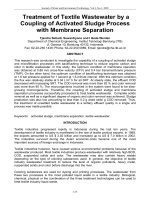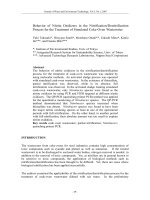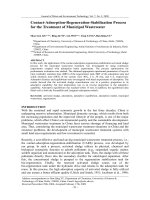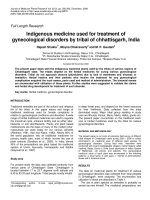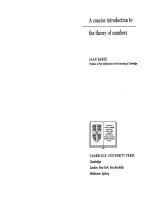- Trang chủ >>
- Khoa Học Tự Nhiên >>
- Vật lý
The raman effect a unified treatment of the theory of raman scattering by molecules derek a long
Bạn đang xem bản rút gọn của tài liệu. Xem và tải ngay bản đầy đủ của tài liệu tại đây (5.81 MB, 611 trang )
The Raman Effect: A Unified Treatment of the Theory of Raman Scattering by Molecules. Derek A. Long
Copyright
2002 John Wiley & Sons Ltd
ISBNs: 0-471-49028-8 (Hardback); 0-470-84576-7 (Electronic)
The Raman Effect
The Raman Effect
A Unified Treatment of the Theory of Raman Scattering by
Molecules
Derek A. Long
Emeritus Professor of Structural Chemistry
University of Bradford
Bradford, UK
Copyright 2002 by John Wiley & Sons Ltd,
Baffins Lane, Chichester,
West Sussex PO19 1UD, England
National 01243 779777
International (+44) 1243 779777
e-mail (for orders and customer service enquiries):
Visit our Home Page on
or
All Rights Reserved. No part of this publication may be reproduced, stored in a retrieval
system, or transmitted, in any form or by any means, electronic, mechanical, photocopying,
recording, scanning or otherwise, except under the terms of the Copyright, Designs and Patents Act
1988 or under the terms of a licence issued by the Copyright Licensing Agency, 90
Tottenham C ourt Road, London, W1P 9HE, without the permission in writing of the
Publisher.
Other Wiley Editorial Offices
John Wiley & Sons, Inc., 605 Third Avenue,
New York, NY 10158-0012, USA
Wiley-VCH Verlag GmbH, Pappelallee 3,
D-69469 Weinheim, Germany
John Wiley Australia, 33 Park Road, Milton,
Queensland 4064, Australia
John Wiley & Sons (Asia) Pte Ltd, 2 Clementi Loop #02-01,
Jin Xing Distripark, Singapore 129809
John Wiley & Sons (Canada) Ltd, 22 Worcester Road,
Rexdale, Ontario, M9W 1L1, Canada
Library of Congress Cataloguing in Publication Data
Long, D. A. (Derek Albert)
The Raman effect : a unified treatment of the theory of Raman scattering by molecules /
Derek A. Long.
p. cm.
Includes bibliographical references and index.
ISBN 0-471-49028-8 (acid-free paper)
1. Raman spectroscopy. I. Title.
QD96.R34 L66 2001
535.8
0
46—dc21
2001046767
British Library Cataloguing in Publication Data
A catalogue record for this book is available from the British Library
ISBN 0 471 49028 8
Typeset in 11/13pt Times by Laserwords Private Limited, Chennai, India
Printed and bound in Great Britain by Biddles Ltd, Guildford and King’s Lynn
This book is printed on acid-free paper responsibly manufactured from sustainable forestry,
in which at least two trees are planted for each one used for paper production.
Dedicated to
Edward and William Long,
grandsons.
vii
Contents
Preface xix
Acknowledgements xxiii
Part One Theory 1
1 Survey of Light-scattering Phenomena 3
1.1 Introduction 3
1.2 Some Basic Definitions 4
1.3 Rayleigh and Raman Scattering 5
1.3.1 Description 5
1.3.2 Energy transfer model 7
1.4 Hyper-Rayleigh and Hyper-Raman Scattering 10
1.4.1 Description 10
1.4.2 Energy transfer model 10
1.5 Second Hyper-Rayleigh and Second Hyper-Raman Scattering 11
1.5.1 Description 11
1.5.2 Energy transfer model 11
1.6 Coherent anti-Stokes and Coherent Stokes Raman Scattering 11
1.7 Stimulated Raman Gain and Loss Spectroscopy 13
1.8 Typical Spectra 14
1.9 Bases for the Theoretical Treatment of Rayleigh and
Raman Scattering 16
1.10 Historical Perspective 16
viii Contents
1.11 Caveat 17
References 17
2 Introduction to Theoretical Treatments of Incoherent Light Scattering 19
2.1 General Considerations 19
2.2 Induced Oscillating Electric Dipoles as Sources of
Scattered Radiation 21
2.3 Basis of the Classical Theory of Light Scattering 22
2.4 Basis of the Quantum Mechanical Treatment
of Incoherent Light-Scattering Phenomena: Electric Dipole Case 24
2.5 Extension of Quantum Mechanical Treatment of Incoherent
Light Scattering to Include Magnetic Dipole and Electric
Quadrupole Cases 27
2.6 Comparison of t he Classical and Quantum Mechanical
Treatments of Light Scattering 28
2.7 The Way Ahead 29
3 Classical Theory of Rayleigh and Raman Scattering 31
3.1 Introduction 31
3.2 First-order Induced Electric Dipole 31
3.3 Frequency Dependence of the First-order Induced Electric
Dipole 34
3.4 Classical Scattering Tensors
a
Ray
and a
Ram
k
35
3.5 Selection Rules for Fundamental Vibrations 36
3.5.1 General considerations 36
3.5.2 Diatomic molecules 36
3.5.3 Polyatomic molecules 38
3.6 Selection Rules for Overtones and Combinations 43
3.7 Coherence Properties of Rayleigh and Raman Scattering 44
3.8 Limitations of the Classical Theory 45
3.9 Example of Rayleigh and Raman Scattering 45
3.10 Presentation of Raman Spectra 47
References 48
4 Quantum Mechanical Theory of Rayleigh and Raman Scattering 49
4.1 Introduction 49
4.2 Time-dependent Perturbation Theory and
a
fi
50
4.3 Qualitative Discussion of ˛
fi
54
4.3.1 Frequency denominators 55
4.3.2 Transition electric dipole numerators 56
4.3.3 Selection rules 58
4.4 Tensorial Nature of the Transition Polarizability and its Symmetry 58
4.5 Born–Oppenheimer Approximation and the Transition
Polarizability Tensor 61
Contents ix
4.6 Simplification of ˛
e
f
v
f
:e
g
v
i
: General Considerations 64
4.7 Simplification by Radical Approximation: the Placzek
Transition Polarizability 65
4.8 Simplification of ˛
e
f
v
f
:e
i
v
i
by Stages 68
4.8.1 Introduction of Herzberg–Teller vibronic coupling 68
4.8.2 Identification of non-resonance and resonance
situations 75
4.9 Normal Electronic (and Vibronic) Raman Scattering 77
4.10 Normal Pure Vibrational Raman Scattering 78
4.11 Electronic (and Vibronic) Resonance Raman Scattering 81
4.12 Vibrational Resonance Raman Scattering 83
4.13 Units and Orders of Magnitude 83
References 84
5 Vibrational Raman Scattering 85
5.1 Introduction 85
5.2 The Placzek Vibrational Transition Polarizability:
Recapitulation 86
5.2.1 Cartesian basis 86
5.2.2 The spherical basis 88
5.3 Definition of Illumination–Observation Geometry 89
5.4 Intensity of Scattered Radiation: Some General Considerations 94
5.4.1 Development of a symbol for scattered intensity 94
5.4.2 Scattering cross-section 95
5.5 Intensity Formulae and Polarization Characteristics for a General
Vibrational Transition in Various Illumination–Observation
Geometries 97
5.5.1 General considerations 97
5.5.2 Linearly polarized incident radiation 98
5.5.3 Natural incident radiation 102
5.5.4 Angular dependence of scattered intensity 103
5.5.5 Circularly polarized incident radiation 106
5.5.6 Symmetry and depolarization ratios, reversal
coefficients and degrees of circularity 109
5.6 Stokes Parameters for Scattered Radiation 113
5.7 Specific Vibrational Transitions 116
5.8 Vibrational Selection Rules 120
5.9 Patterns of Vibrational Spectra 123
5.10 Orders of Magnitude 126
5.11 Epilogue 127
References 131
Reference Tables for Chapter 5 132
Reference Table 5.1: Definitions for IÂ; p
s
,p
i
132
x Contents
Reference Table 5.2(a) to 5.2(g): Intensities, Polarization
Properties and Stokes Parameters for Vibrational Raman
(and Rayleigh) Scattering 132
Reference Table 5.3: Symmetry classes for x, y, z, the rotations
R
x
, R
y
and R
z
, and the components of the cartesian basis
tensor
c
a. 145
6 Rotational and Vibration–Rotation Raman Scattering 153
6.1 Introduction 153
6.2 Irreducible Transition Polarizability Components 154
6.3 Symmetric Top 156
6.3.1 Selection rules 156
6.3.2 Placzek invariants
G
j
fi
157
6.3.3 Intensities 167
6.3.4 Subsequent development 169
6.4 Rotational and Vibrational Terms 169
6.5 Statistical Distribution of Molecular Population 171
6.6 Diatomic Molecule 173
6.6.1 Introduction 173
6.6.2 Heteronuclear diatomic molecule: pure rotation 174
6.6.3 Heteronuclear diatomic molecule: vibration–rotation 175
6.6.4 Homonuclear diatomic molecule: nuclear spin degeneracy 179
6.6.5 Intensity distribution 180
6.7 Symmetric Top Molecule 186
6.7.1 Introduction 186
6.7.2 Symmetric top: pure rotation 187
6.7.3 Symmetric top: vibration–rotation 191
6.7.4 Intensities 203
6.8 Linear Molecules 204
6.8.1 Rotation and vibration-rotation Raman spectra 204
6.8.2 Intensities 207
6.9 Contributions from Electronic Orbital and Spin Angular Momenta 208
6.10 Spherical Top Molecules 210
6.11 Asymmetric Top Molecules 211
6.12 Epilogue 211
References 213
Reference Tables for Chapter 6 214
Introduction 214
Reference Tables 6.1 to 6.4 216
7 Vibrational Resonance Raman Scattering 221
7.1 Introduction 221
7.2 Vibrational Transition Polarizability Tensor Components in the
Resonance Case, Based on Perturbation Theory 222
Contents xi
7.3 Comparison of the A
VI
,B
VI
,C
VI
and D
VI
Terms 224
7.3.1 The A
VI
term 224
7.3.2 The B
VI
term 227
7.3.3 The C
VI
term 229
7.3.4 The D
VI
term 229
7.3.5 Subsequent developments 230
7.4 A
VI
Term Raman Scattering from Molecules with Totally
Symmetric Modes 231
7.4.1 A
VI
term Raman scattering from molecules with one
totally symmetric mode 231
7.4.2 A
VI
term Raman scattering from molecules
with more than one totally symmetric mode: general
considerations 237
7.4.3 A
VI
term Raman scattering from totally symmetric modes
when
k
is very small 238
7.5 A
VI
Term Raman Scattering Involving Non-Totally Symmetric
Modes 239
7.5.1 General considerations 239
7.5.2 A
VI
term scattering involving a change of molecular
symmetry of the resonant excited state 239
7.5.3 A
VI
term scattering involving excited state Jahn–Teller
coupling 240
7.5.4 Summary of excited state Jahn–Teller effects in
resonance Raman scattering 240
7.6 B
VI
Term Scattering Involving Vibronic Coupling of the Resonant
Excited State to a Second Excited State 241
7.6.1 Introduction 241
7.6.2 B
VI
term scattering from molecules with non-totally
symmetric modes 241
7.6.3 B
VI
term scattering from molecules with totally
symmetric modes 244
7.7 Symmetry, Raman Activity and Depolarization Ratios 246
7.7.1 General symmetry considerations 246
7.7.2 The A
VI
term 247
7.7.3 The B
VI
term 250
7.8 Time-Dependent Formulation of Resonance Raman Scattering 262
7.8.1 Introduction 262
7.8.2 Transformation of the A
VI
term to a time-dependent
expression 263
7.8.3 The time-dependent interpretation of resonance Raman
scattering 264
7.9 Continuum Resonance Raman Scattering 266
References 270
xii Contents
8 Rotational and Vibration–Rotation Resonance Raman Scattering 271
8.1 Introduction 271
8.2 General Expression for ˛
fi
for a Symmetric Top Molecule 272
8.3 General Expression for ˛
j
m
fi
274
8.4 Contraction of General Expression for ˛
j
m
fi
274
8.5 The Quadratic Term 275
8.6 Selection Rules 276
8.7 Evaluation of j˛
j
m
fi
j
2
277
8.8 Intensities and Depolarization Ratios 279
8.9 An Illustrative Example 283
8.10 Concluding Remarks 287
Reference 287
9 Normal and Resonance Electronic and Vibronic Raman Scattering 289
9.1 Introduction 289
9.2 Normal Electronic and Vibronic Raman Scattering 289
9.2.1 General considerations 289
9.2.2 A
III
-term scattering 290
9.2.3 B
III
C C
III
-term scattering 291
9.2.4 D
III
-term scattering 292
9.2.5 Transition tensor symmetry 292
9.3 Resonant Electronic and Vibronic Raman Scattering 292
9.3.1 General considerations 292
9.3.2 A
V
-term scattering 293
9.3.3 B
V
-term scattering 296
9.3.4 C
V
-term scattering 297
9.3.5 D
V
-term scattering 297
9.4 Selection Rules in Electronic Raman Spectra 297
9.4.1 General symmetry considerations 297
9.5 Intensities and Polarization Properties of Electronic Raman
Scattering 301
9.5.1 Intensities: general considerations 301
9.5.2 Excitation profiles 301
9.5.3 Depolarization ratios 302
10 Rayleigh and Raman Scattering by Chiral Systems 303
10.1 Introduction 303
10.2 Outline of the Theoretical Treatment 305
10.3 Intensities of Optically Active Rayleigh Scattering 310
10.3.1 General considerations 310
10.3.2 Intensity formulae 314
10.3.3 Stokes parameters 317
Contents xiii
10.4 Intensities of Optically Active Raman Scattering 321
10.4.1 General considerations 321
10.4.2 Discussion of intensities and isotropic invariants 323
10.4.3 Placzek polarizability theory and optically
active scattering 324
10.5 Symmetry Considerations 326
10.6 Concluding Remarks 327
Reference 327
Reference Tables for Chapter 10 328
Part Two Appendices 337
Introduction 339
A1 The Right-handed Cartesian Axis System and Related Coordinate
Systems 341
A1.1 Introduction 341
A1.2 The Right-handed Cartesian Axis System 342
A1.3 Cartesian Coordinate System 344
A1.4 Cylindrical Coordinate System 344
A1.5 Polar Coordinate System 345
A1.6 Complex Coordinate Systems 347
A2 The Summation Convention 349
A2.1 General Definitions 349
A3 Direction Cosines 351
A3.1 Introduction 351
A3.2 Definitions and Properties of Direction Cosines 351
A3.3 Definitions of Direction Cosines in Other Coordinate Systems 354
A4 Isotropic Averages of Products of Direction Cosines 355
A4.1 Introduction 355
A4.2 Specific Isotropic Averages of Products of Direction Cosines 356
A4.3 General Formulae 358
References 358
A5 The Euler Angles and the Rotation Operator 359
A5.1 Introduction 359
A5.2 Definitions of the Euler Angles and the Rotation Operator 359
A5.3 The Relationship of the Euler Angles to the Polar Coordinates 362
A5.4 Direction Cosines and Euler Angles 362
References 363
xiv Contents
A6 Complex Numbers and Quantities 365
A6.1 Introduction 365
A6.2 Definitions and Operations 365
A6.3 Graphical Representation of Complex Numbers 367
A6.4 Complex Numbers and P olar Coordinates 369
A6.5 Complex Quantities and Physical Phenomena 370
A6.6 Spherical Coordinates 371
Reference 372
A7 Some Properties of Matrices 373
A7.1 Introduction 373
A7.2 Nomenclature 373
A7.3 Some Special Matrices 374
A7.4 Matrix Representation of Simultaneous Linear Equations 377
A7.5 Eigenvalues and Eigenvectors 377
A7.6 Example of Diagonalization of a Matrix 379
A8 Vectors, I 381
A8.1 Introduction: Scalars, Vectors and Tensors 381
A8.2 Basic Definition of a Vector 382
A8.3 Unit Vectors 383
A8.4 Vector Addition, Subtraction and Multiplication by a Scalar 385
A8.5 Multiplication of Two Vectors 385
A8.6 Triple Products of Vectors 390
A8.6.1 AB Ð C 391
A8.6.2 A ÐB ð C 391
A8.6.3 A ðB ð C 392
A8.6.4 ABC 392
A8.7 Formal Definition of a Vector in Terms of its Transformation
upon Rotation of Axes 393
A8.8 Polar and Axial Vectors: Time Even and Time Odd Vectors 394
A8.9 Vector Differentiation 395
A8.9.1 The operator
∇ 395
A8.9.2 The gradient 396
A8.9.3 The divergence 397
A8.9.4 The curl,
∇ ð V 397
A8.9.5 The divergence and the curl illustrated and compared 398
A8.9.6 Composite functions involving
∇ 398
A8.9.7 Successive applications of
∇ 400
A8.9.8 Time derivative of a vector 401
A8.9.9 Caveat 401
A8.10 Change of Basis Vectors and Effect Upon Coordinates
of a Fixed Vector 401
A8.11 The Effect of a Symmetry Operation on Vectors and Basis Vectors 404
Contents xv
A9 Vectors, II 407
A9.1 Introduction 407
A9.2 Cylindrical Coordinates and Basis Vectors 407
A9.3 Polar Coordinates and Polar Basis Vectors 408
A9.4 Spherical Components and Spherical Basis Vectors and Direction
Cosines 409
A9.5 Rotation of Vectors using Spherical Coordinates 413
A9.6 Vectors in n-Dimensional Space 415
References 416
A10 Tensors 417
A10.1 General Definitions 417
A10.2 Representation or Specification of a Tensor 419
A10.3 Transformation of Tensors upon Rotation of Axes 422
A10.4 Some Properties of Tensors 425
A10.4.1 General 425
A10.4.2 Tensors of rank two 425
A10.4.3 Tensors of rank three: the alternating or
Levi–Civit
`
a tensor 426
A10.4.4 Isotropic tensors of various ranks 427
A10.4.5 Tensor contraction 427
A10.5 Irreducible Tensorial Sets 428
A11 Electrostatics 433
A11.1 Introduction 433
A11.2 Force Between Charges 433
A11.3 Electric Field Strength 435
A11.4 Electrostatic Potential 436
A11.5 Gauss’s Law 437
A11.6 The Equations of Poisson and Laplace 438
A12 Magnetostatics 439
A12.1 Introduction 439
A12.2 Magnetic Forces 441
A12.3 The Magnetic Induction 442
A12.4 The Lorentz Force on a Point Charge Moving in a
Magnetic Field 445
A12.5 The Divergence of the Magnetic Induction B 446
A12.6 The Vector Potential A 446
A13 The Interaction of a System of Electric Charges with Electric
and Magnetic Fields 449
A13.1 Introduction 449
A13.2 Point Charges in Molecular Systems 450
xvi Contents
A13.3 Electric Dipole in a Molecular System 450
A13.4 Basic Treatment of the Energy of a Distribution of Point Charges
at Rest in a Uniform Electric Field 451
A13.5 Basic Treatment of Permanent and Induced Molecular Dipoles
in a Uniform Static Electric Field 454
A13.6 Basic Treatment of Macroscopic Polarization and Electric
Susceptibilities 457
A13.7 Basic Treatment of the Electric Displacement for a Uniform
Static Electric Field 460
A13.8 The Implications of Using Dynamic Electric Fields 461
A13.9 More General Treatment of Energy of Interaction of Point Charges
at Rest in a Static Electric Field 462
A13.10 Interaction of C harges in Motion with a Static Magnetic Field 466
Reference 470
A14 The Polarizability Tensor 471
A14.1 Introduction 471
A14.2 The Polarizability Tensor in the Cartesian Basis 472
A14.2.1 General considerations 472
A14.2.2 Reduction of the tensor 473
A14.2.3 The polarizability ellipsoid 475
A14.2.4 Transformation of
c
a under rotation of axes 477
A14.3 The Polarizability Tensor in the Spherical Basis 477
A14.3.1 General definitions 477
A14.3.2 Reduction of the tensor
s
a 479
A14.3.3 Transformation of
s
a under rotation of axes 481
A14.4 The Relation Between the ˛
and the ˛
481
A14.5 Irreducible Polarizability Tensors and their Components 482
A14.6 Transformation Properties of t he ˛
j
m
under Rotations 486
A14.7 Isotropic Averages and Tensor Invariants 486
A14.7.1 General considerations 486
A14.7.2 Isotropic averages and rotational invariants G
j
in terms
of the ˛
j
m
487
A14.7.3 Isotropic averages and rotational invariants
G
j
in terms
of the ˛
488
A14.7.4 Isotropic averages and rotational invariants
G
j
in terms
of the ˛
490
A14.7.5 Isotropic averages and the rotational invariants
G
j
,
a, υ and for the cartesian basis 490
A14.7.6 Isotropic averages and rotational invariants,
G
j
, a,
υ and for the spherical basis 494
References 495
Contents xvii
A15 The Optical Activity Tensors, G,
GGG , A and AAA 497
A15.1 Introduction 497
A15.2 Isotropic Averages of the Type h
aG
0
i 497
A15.3 Isotropic Averages of the Type h
aAi 499
A15.4 Other Tensor Invariants 500
Reference 501
A16 Maxwell Equations in Vacuum and in Media 503
A16.1 The Fundamental Equations 503
A16.2 Case I: the Maxwell Equations in Vacuum 507
A16.3 Case II: the Maxwell Equations in a Linear Medium
with D 0and D 0 508
A16.4 Case III: the Maxwell Equations in a Non-Linear Medium
with D 0and D 0 509
A16.5 Case IV: the Maxwell Equations in a Linear Medium
with 6D 0and 6D 0 511
A17 Monochromatic Plane Harmonic Waves in Vacuum and in
a Non-absorbing Linear Medium 513
A17.1 General Wave Equation in Vacuum 513
A17.2 Monochromatic Plane Harmonic Electromagnetic Wave in
Vacuum 514
A17.2.1 Solution of the wave equation for the vector E 514
A17.2.2 Solution of the wave equation for the vector B 518
A17.2.3 Energy considerations for a plane harmonic
electromagnetic wave in vacuum 522
A17.3 The Exponential Representation of Harmonic Waves 526
A17.4 Monochromatic Plane Harmonic Wave in a Homogeneous,
Isotropic and Linear Medium 530
A18 The Transition Polarizability Tensor
a
fi
533
A18.1 Introduction 533
A18.2 The Restrictions r 6D i, f 533
A18.3 The Relative Signs of i
r
535
References 536
A19 Clebsch–Gordan Coefficients and Wigner 3-j and 6-j Symbols 537
A19.1 Introduction 537
A19.2 Clebsch–Gordan Coefficients 538
A19.3 Wigner 3-j Symbols 544
A19.4 Wigner 6-j Symbols 546
Reference 550
Reference Table A19.1 551
xviii Contents
A20 Sources of Electromagnetic Radiation 555
A20.1 Introduction 555
A20.2 The Oscillating Electric Dipole as a Source 555
A20.3 The Oscillating Magnetic Dipole as a Source 561
A20.4 The Oscillating Electric Quadrupole as a Source 562
A20.5 Scattering from Chiral Molecules 564
A21 Polarization of Electromagnetic Radiation 565
A21.1 Introduction 565
A21.2 States of Polarization: Monochromatic Radiation 565
A21.2.1 Linear polarization 565
A21.2.2 Elliptical and circular polarization 566
A21.2.3 Stokes parameters 570
A21.2.4 Stokes parameters for scattered radiation 572
A21.3 States of Polarization: Quasi-Monochromatic Radiation 573
A21.4 Change of Polarization: Depolarization Ratios, Reversal
Coefficients and Degrees of Circularity 575
Further Reading 579
Index 585
xix
Preface
Many ingenious practizes in all trades, by a connexion
and transferring of the observations of one Arte, to the
use of another, when the experiences of severall misteries
shall fall under the consideration of one man’s mind.
Francis Bacon
Raman spectroscopy is now finding wide-ranging application in pure and applied science
and the number of original papers devoted to this area of spectroscopy continues to grow.
This is largely the result of significant advances in the equipment available, particularly
laser excitation sources, spectrometers, detectors, signal processors and computers.
It seems timely, therefore, to provide an integrated treatment of the theory underlying
Raman spectroscopy. Of course there are already a number of edited books and reviews
dealing with various aspects of the subject, but this book is the result of the phenomenon of
Raman spectroscopy falling ‘under the consideration of one man’s mind’ as Francis Bacon
put it. My objective has been to present a unified theoretical treatment which is reasonably
complete and adequately rigorous but nonetheless readable. My hope is that this will
provide a s ound basis for the effective use of more highly specialized review articles.
As to completeness, I have had to put some restrictions on the coverage, partly because
the subject is so vast and partly because of my own limitations. Therefore the treatments
developed here relate mainly to scattering by a system of freely orienting, non-interacting
molecules or by systems which approximate to this. As to rigour, I have endeavoured to
explain in words, as far as possible, the inwardness of the mathematics and physics which
are necessarily involved. I have particularly tried to avoid taking refuge behind that often
overworked phrase ‘as is well known’.
An effective theoretical treatment demands a variety of carefully honed mathematical
and physical tools. To keep the treatment in the main text uncluttered, these tools are
xx Preface
developed in comprehensive Appendices to which cross-references are made in the main
text. These Appendices should also ensure that the main text is useful to readers with a
wide variety of scientific backgrounds and experience.
As far as possible the symbols used to represent physical quantities are based on the
IUPAC recommendations but to avoid excessive embroidery with subscripts and super-
scripts it has been necessary to introduce a few new symbols, all of which are clearly
defined. The SI system of units is used throughout, except in those few instances where
spectroscopists commonly adhere to historical units, as for example the unit cm
1
for
wavenumber and related quantities.
In the main text I have limited citations of the literature. This has enabled me to use the
Harvard system and quote names of authors and the dates of publication directly in the
text. I find this preferable to the anonymity and lack of historical sequence which result
from the use merely of reference numbers in the text. More complete lists of publications
are provided in the section entitled Further Reading, located at the end of the book.
The writing of this book has been a somewhat lengthy process and I have had to learn a
great deal along the way despite more than 50 years of work in this field. Happily I have
been able to find the time and the energy required. The University of Bradford enabled me
to free myself of administrative responsibilities by allowing me to take early retirement
and then reappointed me in an honorary capacity and provided excellent facilities for
research and scholarship. I am very grateful for these arrangements.
I am also much indebted to a number of other universities and institutions which
invited me to spend short periods with them so that I could use their libraries and benefit
from discussions with colleagues. In France I would mention the National Laboratory for
Aerospace Research (ONERA), and the Universities of Bordeaux I, Lille, Paris VI and
Reims. In Italy I would mention the University of Bologna and the European Laboratory
for Nonlinear Spectroscopy (LENS), attached to the University of Florence. In this country
I have made frequent use of the excellent facilities of the Radcliffe Science Library,
Oxford University. My periods in Oxford were made all the more pleasurable by the
kindness of my old Oxford College, Jesus, in making me a supernumerary member of its
Senior Common Room for a period. Nearer home, the J. B. Priestley Library of Bradford
University has also been much consulted and I am particularly indebted to Mr John
Horton, deputy librarian, for his unstinting help.
The following friends in the community of Raman spectroscopists have kindly read
and commented fruitfully upon sections of this book: A. Albrecht, D. L. Andrews,
L. D. Barron, J. Bendtsen, H. Berger, A. D. Buckingham, R. J. H. Clark, T. J. Dines,
H. Hamaguchi, S. Hassing, L. Hecht, M. Hollas, W. J. Jones, W. Kiefer, I. M. Mills,
O. Mortensen, H. W. Schr
¨
otter, G. Turrell, A. Weber, R. Zare and L. D. Ziegler. I
acknowledge with gratitude their efforts which have eliminated many errors and
ambiguities. I am also grateful to Claude Coupry and Marie-Th
´
er
`
ese Gousset for providing
Plate 5.1 and to H. G. M. Edwards for providing Plate 5.2.
I would also like to record my appreciation of the patience and continued support
of John Wiley and Sons. I would mention particularly Dr Helen McPherson, Chemistry
Publisher, who has been most considerate throughout; and Mr Martin Tribe who has been
an efficient and imperturbable Production Coordinator.
Preface xxi
Very special thanks are due to my wife Moira. She has very ably undertaken most
of the word-processing of the text, helped considerably with the style and presentation,
and provided loving encouragement. Rupert, another member of the family, has also
earned honourable mention. His insistence upon regular walks has helped to offset the
sedentary effects of authorship and his relaxed presence in my study has been calming
and companionable.
It would be unrealistic to expect that this wide-ranging book will be entirely free of
errors. In the words of Evan Lloyd, an eighteenth century Welshman, also a graduate of
Jesus College, Oxford, I can only plead that
‘Earnest is each Research, and deep;
And where it is its Fate to err,
Honest its Error, and Sincere.’
December 2001 Derek A. Long
Acknowledgements
Comme quelqu’un pourrait dire de moi
que j’ai seulement fait ici un amas de fleurs ´etrang`eres,
n’ayant fourni du mien que le filet `a les lier.
M. E. Montaigne
I am grateful for permission to reproduce the material listed below.
Figure 5.11, Plate 5.2 – Edwards, H. G. M., Russell, N. C. and Wynn-Williams, D. D.
(1997) Fourier-Transform Raman Spectroscopic and Scanning Electron Microscopic Study
of Cryptoendolithic Lichens from Antarctica. J. Raman Spectrosc., 28, 685, John Wiley
& Sons, Ltd, Chichester. Reproduced with permission from John Wiley & Sons, Ltd,
Chichester.
Figure 6.13 – from Bendtsen, J. (1974). J. Raman Spectrosc., 2, 133. Reproduced with
permission from John Wiley & Sons, Ltd, Chichester.
Figure 6.14 – from Bendtsen, J. and Rasmussen, F. (2000). J. Raman Spectrosc., 31, 433.
Reproduced with permission from John Wiley & Sons, Ltd, Chichester.
Table 7.1 – from Mortensen, O. S. and Hassing, S. (1980). Advances in Infra-red and
Raman Spectroscopy, volume 6, 1, eds. R. J. Clark and R. E. Hester, Wiley-Heyden,
London. Reproduced with permission from John Wiley & Sons, Ltd, Chichester.
Figures 7.6–7.12 inclusive – from Clark, R. J. H. and Dines, T. J. (1986). Resonance
Raman Spectroscopy and its Application to Inorganic Chemistry. Angew. Chem. Int. Ed.
Engl., 25, 131. Reproduced with permission from Wiley-VCH Verlag GmbH, Weinheim.
xxiv The Raman Effect
Figures 7.14–7.18 inclusive – from Kiefer, W. (1995). Resonance Raman Spectroscopy
in Infrared and Raman Spectroscopy, ed. B. Schrader. VCH Verlag GmbH, Weinheim.
Reproduced with permission from Wiley-VCH Verlag GmbH, Weinheim.
Figures 8.2, 8.3, 8.5, 8.6 – from Ziegler, L. D. (1986). J. Chem. Phys., 84, 6013. Repro-
duced with permission of the American Institute of Physics.
Table 8.2 – from Ziegler, L. D. (1986). J. Chem. Phys., 84, 6013. Reproduced with per-
mission of the American Institute of Physics.
Figure 10.1 – from Nafie, L. A. and Che, D. (1994). Theory and Measurement of Raman
Optical Activity, in Modern Non-linear Optics, part 3, eds. M. Evans and S. Kielich.
Reproduced with permission from John Wiley & Sons, Inc., New York.
Figures A8.6, A8.7, A8.8 – from Barron, L. D. (1983). Molecular Light Scattering and
Optical Activity. Cambridge University Press, Cambridge. Reproduced with permission
from Cambridge University Press.
Figure A8.10a, b, c – from Atkins, P. W. (1983). Molecular Quantum Mechanics, Oxford
University Press, Oxford. Reproduced by permission of Oxford University Press.
Reference Table A19.1 – from Zare, R. N. (1988). Angular Momentum, John Wiley &
Sons, Inc.: New York. Reproduced with permission from John Wiley & Sons, Inc., New
York.
I also acknowledge my indebtedness to the literature of Raman spectroscopy in general
and in particular to the following authors and their publications upon which I have
drawn for the topics stated. For scattering by chiral systems, reviews and books by
L. D. Barron, L. Hecht and L. A. Nafie; for rotational and vibration-rotation Raman scat-
tering, reviews by S. Brodersen, by W. J. Jones and by A. Weber; for vibrational and
electronic resonance Raman scattering, reviews by R. J. H. Clark and T. J. Dines, by
H. Hamaguchi and by W. Kiefer; for rotational and vibration-rotation resonance Raman
scattering, reviews by L. Ziegler; and for irreducible transition polarizability tensors, a
review by O. S. Mortensen and S. Hassing. Full references will be found in the Section
entitled Further Reading.
The treatments of the classical theory of Rayleigh and Raman scattering, vibrational
Raman scattering and the properties of electromagnetic radiation and many of the Refer-
ence Tables are based upon my earlier book, the copyright of which has been assigned
to me by the original publishers.
D. A. Long.
The Raman Effect: A Unified Treatment of the Theory of Raman Scattering by Molecules. Derek A. Long
Copyright
2002 John Wiley & Sons Ltd
ISBNs: 0-471-49028-8 (Hardback); 0-470-84576-7 (Electronic)
585
Index
Note: Page references followed by ‘f’ represents a figure, ‘n’ represents a footnote and ‘t’
represents a table.
A
A
III
term active modes 295
A
V
term Raman scattering 293–296
A
VI
term 224–227, 247–250
transformation to time-dependent expression
263
A
VI
term Raman scattering
from molecules with totally symmetric
modes 231–239
non-totally symmetric modes 239–241
A
VI
term scattering 290
involving excited Jahn-Teller coupling 240
molecular symmetry change of the resonant
excited state 239–240
absorption energy 55
absorption spectra 235f, 302
adiabatic approximation see
Born-Oppenheimer approximation
adiabatic polarizability 66–67, 79
adjoint matrix 375–376n
alternating tensors 427, 522
ammonia, Raman spectra of 283–287
Amp
`
ere’s law 504
amplitude 369, 473, 517–518
angular frequency 4–5, 14, 45, 517–518
angular momentum 388
combination rules 485
coupling 541, 548
orbital 173, 466
transformation matrices 155
vectors 394, 396
vibrational 198
anharmonic oscillators 125, 269
anharmonic vibrational functions 121
anharmonic wave functions, symmetry
properties of 123
anharmonicity 43–44, 122, 124
anisotropic invariants 158
anisotropy 36, 495–498
anti-Stokes bands 5, 47, 182
anti-Stokes lines 6, 124
anti-Stokes Raman frequency 12
anti-Stokes Raman scattering 7, 47, 52, 118,
120, 133, 170–171
anti-Stokes scattered intensity 119
anti-Stokes spectrum 180–181
586 Index
anti-Stokes transitions 119, 214, 323
associate matrix 376n
asymmetric top molecules 171, 186, 211–212
axial vectors 394–395, 424
B
B
III
and C
III
term scattering 291–292
B
V
term scattering 296–297
B
VI
term scattering, involving vibronic
coupling 241–245
B
VI
terms 227–229, 250–262
symmetric requirement of 250
back-scattering radiation 107–108, 110, 113
band shape 15
band width 15, 236
basis vectors 384–385, 407–408
Biot-Savart law 442, 446
Bolzmann distribution law 119
bond polarizability 39–40, 128
Born-Oppenheimer (adiabatic) approximation
68, 74, 121, 153, 228, 246, 272, 298, 327
and transition polarizability tensors 61–62,
535n
bra states, perturbed 70
Brillouin scattering 17
C
C
V
term scattering 297
C
VI
term 223, 229
carbon tetrachloride (CCl
4
)
Rayleigh and Raman spectra of 48f
Stokes Raman spectra of 112f
cartesian axis system and related coordinate
systems, right-handed 342–347
cartesian basis 86–87
cartesian basis vectors 384
cartesian coordinate system 344
cartesian coordinates 92, 369, 407
cartesian tensor components 164
centrifugal stretching 177, 194
centrosymmetric molecules 204
chiral molecules, scattering from 564
chiral tensors, invariants of 315
circular intensity differential (CID) 315
circular polarization 569
left and right 93–94, 132t
reversal of 107–108
circular polarized radiation 92, 314n
incident 106–109, 114–115
left-handed 565, 567
right-handed 113, 565, 567
circularity, degree of 109–113–114, 116, 136,
319, 323, 574–577
classical electromagnetic waves 4
classical polarizability tensors 28
classical and quantum mechanics, comparison
of 28–29
classical scattering tensors 35
classical theory, limitations of 45
Clebsch-Gordan coefficients 160, 340
and Wigner 3-j and 6-j symbols 541–554
Clebsch-Gordan symbols 483
closure theorem 63, 66
coherent anti-Stokes hyper-Raman scattering 3
coherent anti-Stokes Raman scattering (CARS)
3, 11–13, 17
coherent Stokes hyper-Raman scattering 3
coherent Stokes Raman scattering (CSRS) 3,
11–13
colours, analysis of 128
column matrix 393
combination bands 43, 123
combination tones 44
complex conjugate matrix 376
complex coordinate systems 346–347
complex numbers and quantities 365–372
complex transpose matrix 376
Coriolis coupling 210
Coriolis forces 121
Coriolis interactions 198, 203, 205, 210
Coulomb force 435, 445
Coulomb’s law 442
current density vectors 440
cylindrical coordinate system 344–345
cylindrical coordinates 407–408
D
D
III
term scattering 292
D
V
term scattering 297
D
VI
terms 223, 229–230
degenerate vibrations 206
depolarization
change of 574–577
degree of 100–103, 109–113, 115
Index 587
incident linear polarized radiation 138
incident natural radiation 139
Stokes parameters and 114
depolarization ratios 100n, 120, 213–214, 248,
302
intensities and 279–283
reversal coefficients and 168–169
tensor decomposition 136
derived polarizability tensors 32, 35, 39, 112,
117, 119, 471
diatomic molecules 36–38, 174–186, 231
isotropic averages of polarizability tensor
components 216t
Raman spectra of 125, 170, 182
Raman vibrational transition 269
transitions of 214
dielectric constant 460n
dielectric polarization 458n
difference bands, intensities of 123
dipole electronic transitions 226f
dipole lengths 84
dipole moment operators, electric 50, 52, 66
dipole moment vectors, electric 480
dipole moments 41, 43
adiabatic permanent electric 66
electric 22, 370, 450, 454
electronic transition 228
first-order induced transition electric 49–50
permanent 38
pure electronic transition electric 68
real induced transition electric 50, 52
dipole transition vectors 274
dipoles
amplitude of induced 127
permanent 40, 556
direct product 390, 392, 417
direct vector product 474, 480
direction cosines 351–354, 422
isotropic averages of products of 355–358
spherical components and basis vectors and
409–412
direction of polarization 566
direction vectors 384
discrete resonance Raman scattering 56,
221–222
divergence theorem 438, 446–447
DNA, vibrational spectra of 43
Doppler-limited resolution 213
dual circular polarization (DCP) 316, 333, 334t
E
eigenvectors, eigenvalues and 377–379
Einstein summation convention 349–350, 354,
422, 477
elastic scattering 7, 17
electric current 441
electric current density 504–505
electric dipole amplitude 422
electric dipole emission 309
electric dipole transition moments 57, 307
electric dipole vectors 31, 32, 452
permanent 455
electric dipoles 24, 310, 450–451, 463, 554
induced 43–44, 456, 564
linear induced 34
permanent 454
electric displacement 504
electric field, time-dependent 50
electric field strength 3, 435–436
amplitude of 127, 422
gradient tensor 531
electric field vectors 32, 452
electric fields 4, 22, 24, 54, 461
amplitudes 50
electric displacement 460–461
molecular dipoles in 454–457
point charges 451–454, 462–466
electric and magnetic fields, electric c harges
449–470
electric permittivity of vacuum 433
electric polarizability component 468
electric polarization, induced 370–371
electric quadrupoles 21, 463, 465
mechanism 324
operators 28, 303
perturbations 311
quantum mechanics and 27–28
transition moment 25, 307
electric Rayleigh and Raman optical activity
327
electric vector, time-dependent 22
electric vectors 95, 108–109
polarization 566–567
of radiation 98, 570

